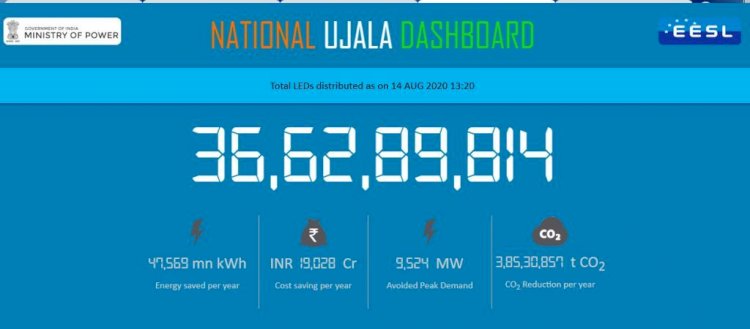Unnat Jyoti by Affordable LED
In non-subsidized LED lamp distribution projects Unnat Jyoti by Affordable LEDs for All
Unnat Jyoti by Affordable LEDs for All (UJALA) was launched by PM NAMO
Track the real time performance dash board here :- http://www.ujala.gov.in/
1.2 Energy Efficiency Services Limited (EESL), a government company under the administrative control of Ministry of Power, Government of India, has been designated as the implementing agency for this programme. For domestic lights, EESL service model enables domestic households to procure LED lights at an affordable price of $0.154/- each and the balance on easy instalment from their electricity bill.
Objectives of the National Programme
- (a) Reduce energy consumption in lighting which helps DISCOMs to manage peak demand.
- (b) Promote the use of the most efficient lighting technology at affordable rates to domestic consumers
which benefits them by way of the reduced energy bill. - (c) Enhance the awareness of consumers about the efficacy of using efficient appliances which in turn
could change their buying preferences from low first cost based purchases to lifecycle cost. - (d) Increase the demand of LED lights by aggregating requirements across the country and provide an
impetus to domestic lighting industry through economies of size. - (e) Encourage and support domestic manufacturing of LED bulbs by sustaining demand making it
consistent with the ‘Make in India’ policy of the Government. - (f) Provide a sustainable service model that obviates the need for upfront capital investment as well as
additional revenue expenditure to pay for the procurement of LED lights. The total cost paid by consumers is
less than the total savings on electricity bills. - (g) Create an understanding about the service model amongst all stakeholders such as industry, government agencies, financial institutions, etc. so that market-based energy efficiency can happen.
- (h) Provide a base model which can not only be replicated in lighting energy efficiency but also in host of other energy-using appliances in domestic and other sectors. For instance, UJALA service model could be used for domestic appliances like fans, refrigerators, ACs, etc. where the consumer preference for purchase is still dictated by first cost and the level of penetration of energy-efficient equipment in less than 10%.
- (i) Create robust arrangements for monitoring and verification of energy savings in a simple and transparent manner.
- (j) Standardise agreements, technical specifications, payments security mechanisms, implementation methodologies, etc. that can reduce the transaction cost and can stimulate replication.
- (k) Create an enabling environment for private sector investments in the lighting sector.
Programme Targets
No of LED lights to be replaced in 3 years 770 million
Expected annual energy savings 100 billion kWh
Expected reduction in installed load 20,000 MW
Estimated capital investment (excluding O&M cost) $ 1.23 billion
Annual estimated GHG emission reductions 79 million tonnes of CO2
What's Your Reaction?












































































